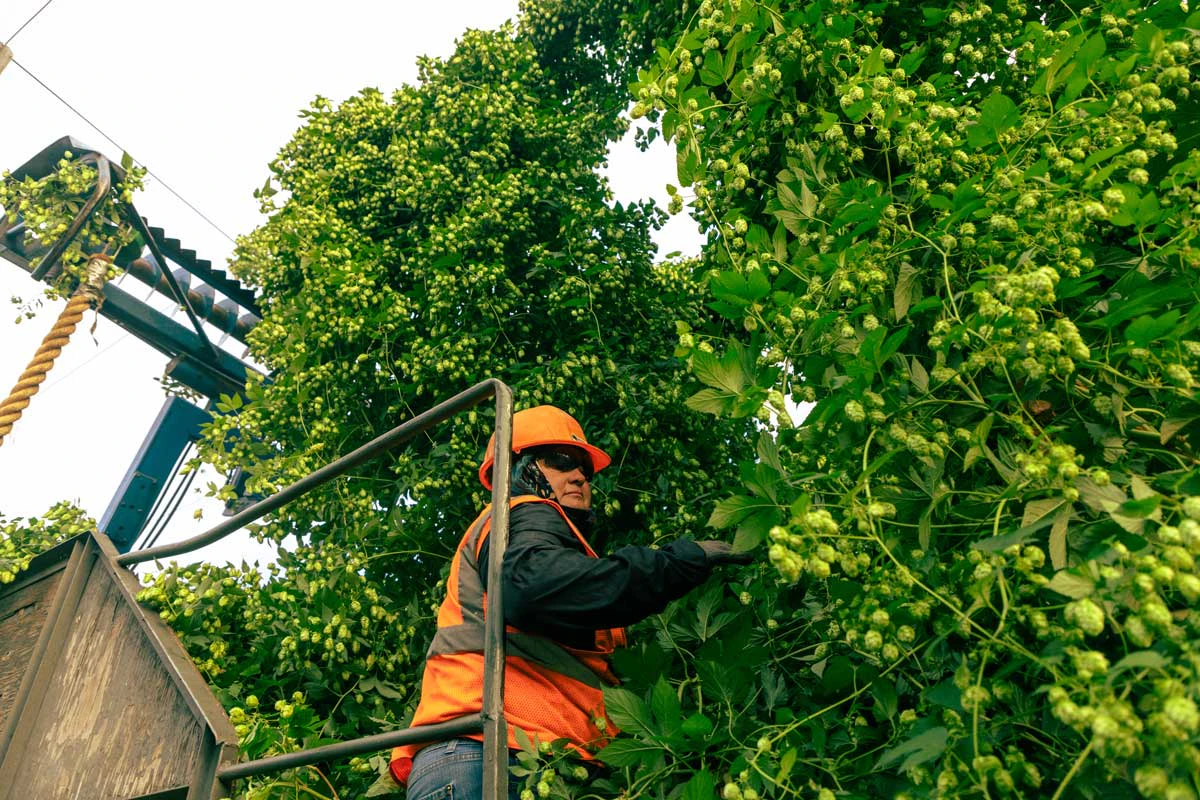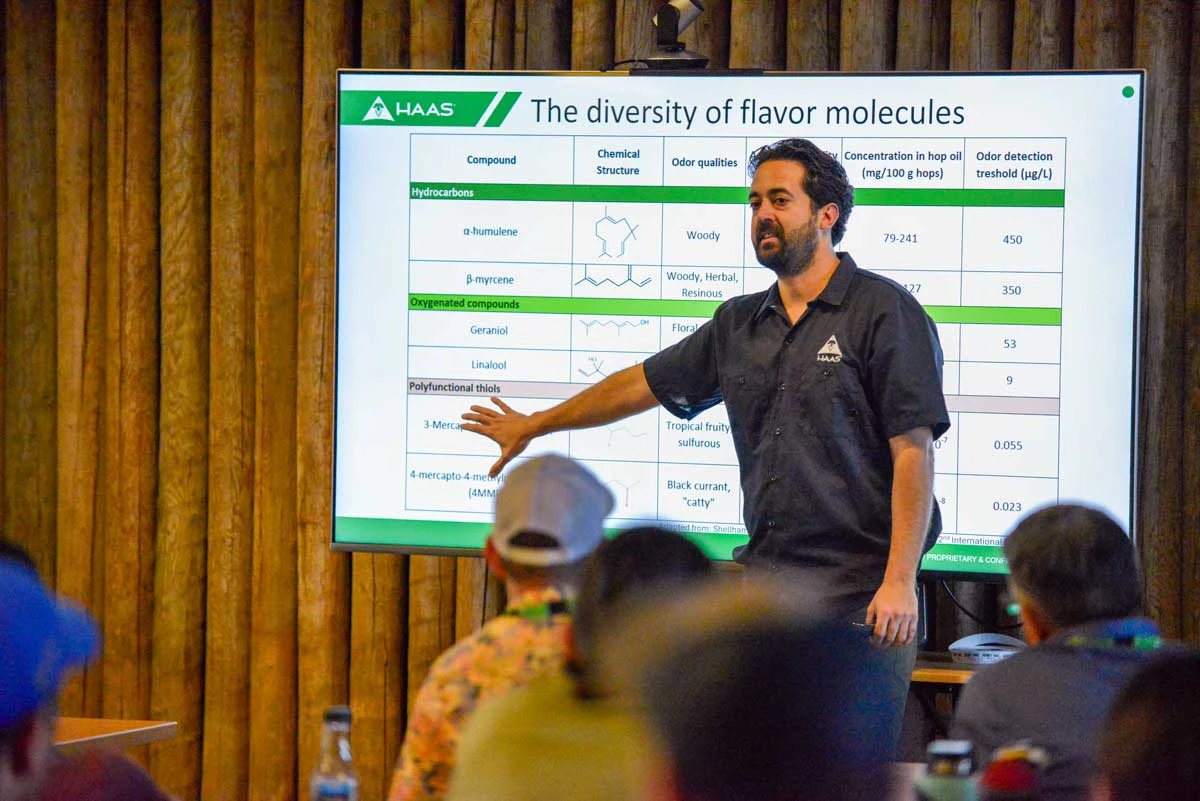
Historically, the phrase “high quality” in hop selection has been shorthand for a few specific, albeit superficial, factors: in-spec alpha-acid levels, low seed counts, and vibrantly green hop cones, among others. A hop that smells great in the field or the belief that it’s “supposed to be a cool variety” are often cited as markers of quality. Conversations about raw materials with hop brokers or growers once started and ended here, limited by a lack of shared understanding of what hops actually are—or could be.
But evolving consumer tastes and modern brewing techniques demand far more from hop suppliers. The brewing industry’s revised focus on flavor-forward hops and its resulting advances in analytical tools and sophisticated sensory analysis have redefined what quality actually means. Today, hops are no longer viewed as simply an essential ingredient; they are sensory instruments whose chemistry, condition, and consistency directly shape a beer’s identity.
At John I. Haas, we have evolved alongside the industry. Across our farms, labs, and brewhouses, quality has become a multidimensional concept—one that blends breeding, cultivation, chemistry, sensory, and how we approach customer selection in ways that didn’t exist a generation ago. In a three-part series, we’ll explore some of the tools and methods brewers should be using today to close the loop on hop quality, starting with redefining their approach to selection.

Drivers of Hop and Harvest Quality
Hop quality can’t be summed up in a single metric—it exists along a spectrum of interdependent factors:
- Chemical composition—Alpha and beta acids, total oil, and key fractions such as myrcene, humulene, and linalool
- Sensory profile—The balance between varietal fingerprint and seasonal nuance
- Physical integrity—Cone structure, moisture, and appearance post-drying and baling
- Consistency and stability—The ability of a lot to perform as expected across multiple brews
What makes this tricky is that these parameters don’t always align. A hop lot with a textbook oil profile can still disappoint in the glass if harvest timing or drying went off target. Likewise, a hop that smells underwhelming raw can reveal exceptional synergy in beer.
Harvest Windows: Where Quality Begins
The harvest window—the period when chemistry, sensory, and yield align—is one of the biggest determinants of hop quality. For some varieties, that window is widening; for others, climate and agronomic pressures are compressing it.
Haas Sensory Panels have observed that even a seemingly minor shift in harvest timing can alter citrus or tropical profiles by more than 30 percent in sensory intensity. As a result, precision harvest management has become as critical as breeding itself.
However, Haas Sensory Panels have also observed that the concept of a single harvest window is outdated. Because of the multidimensional nature of the influences on quality—location, microclimate, soil quality, viral status, rootstock age, agronomic and fertility practices, and even “timing”—we’ve observed clear, consistent trends in sensory profiles that don’t align neatly with “early,” “middle,” and “late.” For example, Citra picked on the same day in Moxee and Wapato can be wildly different, even though they’re managed by the same farm and grown only 10 miles apart.
Suppliers and brewers can leverage this knowledge whether they’re using traditional selection or not.
The Changing Nature of Selection
For large global brewers, hop selection is often a data-driven exercise supported by analytics, large-scale production demands, and long-term supplier agreements. For craft brewers, it’s often a once-a-year sensory sprint through dozens of lots in Yakima or Hallertau.
Each approach reflects the same goal—a reliable sensory outcome—but operates under vastly different constraints. Smaller brewers may select by nose and intuition; larger ones rely on metadata and multiyear lot-performance models.
Best Practices in Selection
No matter the scale, three best practices hold true:
- Conduct side-by-side sensory evaluations—Always assess multiple lots of the same variety together to expose differences in freshness, expression, and drying character.
- Use Certificates of Analysis (CoAs) as context, not verdicts—Analytical data provide valuable clues but never tell the full story.
- Engage the supply chain early—The best results come from year-round communication with growers and suppliers, not just harvest-week selection.

Variability and Data Challenges
Even within a single variety, no two years are identical. Variations in temperature, drought stress, and pest load can shift oil balance and alter aroma character. Growers must often balance yield and quality, adjusting irrigation and drying practices in real time. These small changes ripple down to the sensory experience, turning “bright tropical” one year into “green herbal” the next.
In addition, brewers often underestimate how much variance exists across lots, even within a single variety. Two bales from the same field can smell and taste distinctly different. That’s not necessarily a failure of process; it’s the nature of an agricultural product.
The challenge isn’t just managing the variability—it’s tracking it. Without robust metadata—field data, drying temperature logs, analytical history—it’s almost impossible to correlate sensory shifts with root causes.
Using Data to Manage Chaos
Progressive brewers and suppliers are beginning to classify lots using clustered sensory and analytical profiles—for example, grouping Citra lots as citrus-forward, floral-forward, or sweet fruit–leaning. Tracking these clusters across harvest years allows teams to maintain brand sensory consistency even as raw materials fluctuate.

Sensory and Selection Teams: Training and Calibration
Human bias—often invisible but powerful—can strongly influence hop selection. Fatigue, expectation, and previous experience can all skew sensory evaluation.
At Haas, our teams focus on structured calibration, cross referencing panel impressions with chemical markers and proven sensory lexicons. Breweries, regardless of size, can benefit from similar internal training: establishing shared descriptors, using blind trials, and revisiting calibration throughout the season.
Where Traditional Selection Hits Its Limits
Even with the best-trained noses and the right data in hand, traditional selection has limits. Certain chemical divergences are simply imperceptible, or uncontrollable, by sensory means alone.
As hop breeding advances and weather volatility increase, those unseen differences can have outsized impacts on beer flavor. The industry is headed toward augmented, data-integrated selection systems that combine human expertise with analytical precision.
We’ll explore the Haas Next Gen approach in Part 2 of this series.
Supplier Practices and Quality Expectations
Today’s brewers should expect—nay, demand—transparency from their suppliers. That means:
- Full traceability from farm block to bale to pellet
- CoAs enriched with metadata, including harvest date, drying parameters, and sensory class
- Consistent QC protocols validated across facilities and regions
Modern suppliers aren’t just raw-material vendors; they’re stability partners, providing data and guidance that empower brewers to hit their flavor targets every time.
Defining the Path Forward
Raw-material quality is no longer about what a hop is—it’s about what it does in beer and how reliably it does it. For brewers and suppliers alike, the next era of hop quality will be defined by integration, not just intuition: chemistry with sensory, instinct with data, and farm-level insight with proven brewery performance.
As we’ll explore in Part 2, new tools and methodologies such as the Haas’ Sensory Plus™ engineering process and the new Next Gen Selection platform are designed to make that integration scalable, objective, and repeatable.
In a world where quality keeps evolving, the real challenge isn’t finding the right hop for your beer profile; it’s finding the hop solution that best fits your beer, every time.






